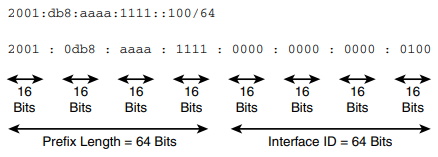In IPv4, the prefix (or network portion) of the address can be identified by a dotted-decimal netmask, commonly referred to as a subnet mask. For example, 255.255.255.0 indicates that the network portion, or prefix length, of the IPv4 address is the leftmost 24 bits. The 255.255.255.0 dotted-decimal netmask can also be written in CIDR notation as /24, indicating the 24 bits in the prefix.
IPv6 address prefixes can be represented much the same way that IPv4 address prefixes are written in CIDR notation. An IPv6 address prefix (the network portion of the address) is represented using the following format:
ipv6-address/prefix-length
The prefix-length is a decimal value indicating the number of leftmost contiguous bits of the address. It identifies the prefix (that is, the network portion) of the address. It is also used with unicast addresses to separate the prefix portion of the address from the Interface ID. The Interface ID is the equivalent to the host portion of an IPv4 address.
Let's look at an example using the address 2001:db8:aaaa:1111::100/64. The longest preferred form in the illustration below note how the /64 prefix length identifies the prefix, or network portion, of the address. The /64 prefix length leaves another 64 bits, which is the Interface ID portion of the address.
Each hexadecimal digit is 4 bits; a hextet is a 16-bit segment.

In the illustration above, just as in IPv4, the number of devices you can have on a network depends on the prefix length. However, due to the 128-bit length of an IPv6 address, there is no need to conserve address space as is needed with IPv4 public addresses.
In the illustration, notice that the /64 prefix length results in an Interface ID of 64 bits. As we will discuss further in Chapter 5, this is a common prefix length for most end-user networks. A /64 prefix length gives us 18 quintillion devices on a single network (or subnet, if you prefer)!

The illustration above shows several prefix length examples: /32, /48, /52, /56, /60, and /64. Notice that all of these examples fall on a nibble boundary, a multiple of 4 bits. Prefix lengths do not necessarily have to fall on a nibble boundary, although in most cases they do. Prefix lengths can also fall within a nibble - for example, /61, /62, or /63. Rick Graziani discusses the prefix lengths, including within the nibble, more in Chapter 5 of IPv6 Fundamentals when he discusses the global unicast address, prefix allocation, and subnetting.
About the Author
Rick Graziani has been an instructor of computer networking and computer science courses at Cabrillo College in Aptos, California since 1994. Rick also teaches networking courses in the Computer Engineering department at the University of California, Santa Cruz and is on the Curriculum Engineering team for Cisco Networking Academy.
Organizations are increasingly transitioning to IPv6, the next generation protocol for defining how devices of all kinds communicate over networks. Now fully updated, IPv6 Fundamentals offers a thorough, friendly, and easy-to-understand introduction to the knowledge and skills you need to deploy and operate IPv6 networks.
Leading networking instructor Rick Graziani explains all the basics simply and clearly, step-by-step, providing all the details you'll need to succeed. You'll learn why IPv6 is necessary, how it was created, how it works, and how it has become the protocol of choice in environments ranging from cloud to mobile and IoT.
Graziani thoroughly introduces IPv6 addressing, configuration options, and routing protocols, including EIGRP for IPv6, and OSPFv3 (traditional configuration and with address families). Building on this coverage, he then includes more in-depth information involving these protocols and processes.
This edition contains a completely revamped discussion of deploying IPv6 in your network, including IPv6/IPv4 integration, dynamic address allocation, and understanding IPv6 from the perspective of the network and host. You'll also find improved coverage of key topics such as Stateless Address Autoconfiguration (SLAAC), DHCPv6, and the advantages of the solicited node multicast address.
Throughout, Graziani presents command syntax for Cisco IOS, Windows, Linux, and Mac OS, as well as many examples, diagrams, configuration tips, and updated links to white papers and official RFCs for even deeper understanding.
• Learn how IPv6 supports modern networks encompassing the cloud, mobile, IoT, and gaming devices
• Compare IPv6 with IPv4 to see what has changed and what hasn't
• Understand and represent IPv6 addresses for unicast, multicast, and anycast environments
• Master all facets of dynamic IPv6 address allocation with SLAAC, stateless DHCPv6, and stateful DHCPv6
• Understand all the features of deploying IPv6 addresses in the network including temporary addresses and the privacy extension
• Improve operations by leveraging major enhancements built into ICMPv6 and ICMPv6 Neighbor Discovery Protocol
• Configure IPv6 addressing and Access Control Lists using a common topology
• Implement routing of IPv6 packets via static routing, EIGRP for IPv6, and OSPFv3
• Walk step-by-step through deploying IPv6 in existing networks, and coexisting with or transitioning from IPv4
Reader Lucas Schultz says, "If you are looking to take the CCNA and IPv6 is not clear to you after Cisco material, this is the book you. This is the best in depth discuss about IPv6 how it works and the mechanisms to make it work. Author made it very easy to read and understand. Highly recommend this book to IT personnel or CCNA certification.



